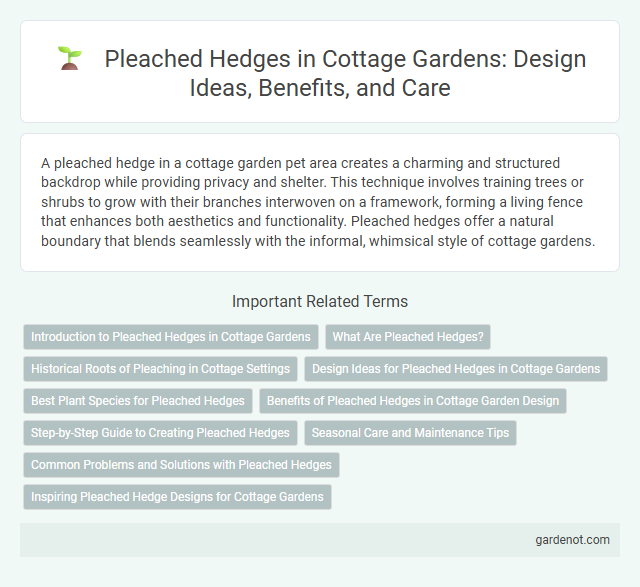A pleached hedge in a cottage garden pet area creates a charming and structured backdrop while providing privacy and shelter. This technique involves training trees or shrubs to grow with their branches interwoven on a framework, forming a living fence that enhances both aesthetics and functionality. Pleached hedges offer a natural boundary that blends seamlessly with the informal, whimsical style of cottage gardens.
Introduction to Pleached Hedges in Cottage Gardens
Pleached hedges create structured green walls by training trees to form a flat, elevated screen, adding architectural interest and privacy in cottage gardens. Commonly used species include hornbeam, lime, and beech, valued for their dense foliage and ease of shaping. This technique enhances traditional cottage garden aesthetics by blending formal design with natural beauty.
What Are Pleached Hedges?
Pleached hedges are a traditional garden technique where trees are planted in a row and their branches are trained and intertwined to form a flat, elevated hedge or screen. This method creates a unique architectural element that provides privacy and structure while allowing light to filter through the canopy. Common tree species used for pleaching include hornbeam, lime, and beech, chosen for their flexible branches and dense foliage.
Historical Roots of Pleaching in Cottage Settings
Pleached hedges trace their origins back to medieval European cottage gardens, where they served as living fences to define property boundaries and create sheltered outdoor rooms. This traditional technique of weaving young tree branches, often hornbeam or lime, into flat, raised screens enabled gardeners to maximize space and improve privacy without solid walls. Historical records highlight pleaching's role in enhancing the charm and structure of cottage landscapes, blending functional horticulture with aesthetic appeal.
Design Ideas for Pleached Hedges in Cottage Gardens
Pleached hedges create vertical structure and add architectural interest in cottage gardens while preserving an airy, open feel. Popular design ideas include lining garden paths with pleached trees such as hornbeam or lime to form elegant, living fences that guide visitors through the garden. Incorporating flowering climbers between the pleached framework enhances seasonal color and softens the geometric lines typical of traditional cottage garden aesthetics.
Best Plant Species for Pleached Hedges
Hornbeam (Carpinus betulus) and lime (Tilia cordata) are ideal for pleached hedges due to their dense foliage and ability to tolerate regular pruning. Beech (Fagus sylvatica) also performs well, providing vibrant seasonal color and maintaining structure. These species create elegant, structured boundaries perfect for traditional cottage garden aesthetics.
Benefits of Pleached Hedges in Cottage Garden Design
Pleached hedges in cottage garden design create structured vertical elements that maximize space and enhance privacy without overwhelming the natural charm. They provide a living framework for climbing plants, promoting biodiversity and seasonal interest through varying foliage and flowers. This technique also boosts wind protection and defines garden rooms, making the garden feel more intimate and organized.
Step-by-Step Guide to Creating Pleached Hedges
Creating pleached hedges involves selecting fast-growing, pliable trees such as hornbeam or lime, which respond well to pruning and training. Begin by planting saplings in a straight line, spaced evenly, then gradually prune and tie their lateral branches to a horizontal framework or wires to form an elevated, flat canopy. Regular maintenance with precise trimming encourages dense foliage and a structured, elegant hedge that enhances the cottage garden's classic charm.
Seasonal Care and Maintenance Tips
Pleached hedges require regular pruning in late winter to maintain their formal shape and encourage healthy growth during the growing season. Applying mulch around the base conserves moisture and suppresses weeds, promoting a robust root system. Seasonal feeding with balanced fertilizer in spring and mid-summer supports vibrant foliage and structural integrity essential for a picturesque cottage garden setting.
Common Problems and Solutions with Pleached Hedges
Pleached hedges often suffer from uneven growth and dieback due to poor pruning techniques or insufficient light penetration. Regular trimming during the growing season encourages dense foliage and maintains the structured framework vital for pleaching. Addressing issues like fungal diseases requires improved air circulation and fungicide application to sustain hedge health and aesthetics.
Inspiring Pleached Hedge Designs for Cottage Gardens
Pleached hedges create structured, elegant boundaries that enhance the natural charm of cottage gardens while maximizing space and light. Popular designs incorporate species like hornbeam or beech to form living walls that provide privacy without overwhelming delicate garden features. Integrating pleached hedges with flowering climbers or seasonal plants adds texture and seasonal interest, making them a versatile choice for inspiring cottage garden layouts.
Pleached hedge Infographic

 gardenot.com
gardenot.com